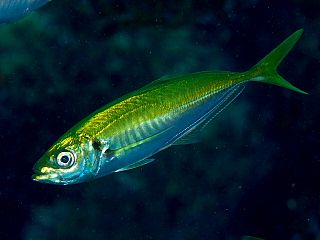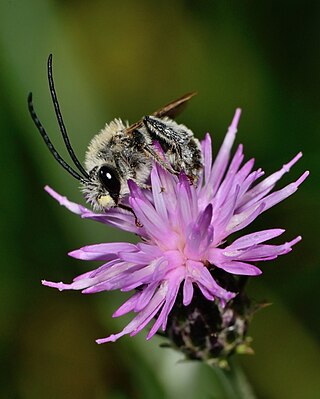
The Squaliformes are an order of sharks that includes about 126 species in seven families.

Calypso is a genus of orchids containing one species, Calypso bulbosa, known as the calypso orchid, fairy slipper or Venus's slipper. It is a perennial member of the orchid family found in undisturbed northern and montane forests. It has a small pink, purple, pinkish-purple, or red flower accented with a white lip, darker purple spottings, and yellow beard. The genus Calypso takes its name from the Greek signifying concealment, as they tend to favor sheltered areas on conifer forest floors. The specific epithet, bulbosa, refers to the bulb-like corms.

William Curtis was an English botanist and entomologist, who was born at Alton, Hampshire, site of the Curtis Museum.

The Carangidae are a family of ray-finned fish that includes the jacks, pompanos, jack mackerels, runners, trevallies, and scads. It is the largest of the six families included within the order Carangiformes. Some authorities classify it as the only family within that order but molecular and anatomical studies indicate that there is a close relationship between this family and the five former Perciform families which make up the Carangiformes.

Jack mackerels or saurels are marine ray-finned fish in the genus Trachurus of the family Carangidae. The name of the genus derives from the Greek words trachys ("rough") and oura ("tail"). Some species, such as T. murphyi, are harvested in purse seine nets, and overfishing has sometimes occurred.
Rudie Hermann Kuiter is an Australian underwater photographer, taxonomist, marine biologist and author of many identification guides to sea fishes. He has described new species of seahorses in the genus Hippocampus.
The elm cultivar Ulmus 'Ramulosa' [: 'twiggy'], Floetbeck elm, was raised in the Floetbeck nurseries, Hamburg, by James Booth & Son, and was first mentioned by Loudon in Arboretum et Fruticetum Britannicum (1838) as Ulmus montana glabra var. ramulosaBooth, but without description. It does not, however, appear in Booth's 1838 list. Loudon listed the tree in a group including Downton Elm, Scampston Elm, and Ludlow Elm, so Green's wych cultivar attribution appears to be an error.

Goodia is a genus of six species of flowering plants in the family Fabaceae, and is endemic to Australia. Plants in the genus Goodia are shrubs with trifoliate leaves. The flowers are arranged in racemes, the sepals with two "lips", the standard petal more or less circular and the fruit is a flattened pod.

John Wilkes was an English printer, bookseller and stationer.

William Kilburn (1745–1818) was an illustrator for William Curtis' Flora Londinensis, as well as a leading designer and printer of calico. A few hundred originals of his water colour designs make up the Kilburn Album, housed at the Victoria and Albert Museum in London.

Dasornis is a genus of prehistoric pseudotooth birds. These were probably close relatives of either pelicans and storks or waterfowl; they are placed in the order Odontopterygiformes to account for this uncertainty.

Eels are ray-finned fish belonging to the order Anguilliformes, which consists of eight suborders, 20 families, 164 genera, and about 1000 species. Eels undergo considerable development from the early larval stage to the eventual adult stage and are usually predators.

An anchovy is a small, common forage fish of the family Engraulidae. Most species are found in marine waters, but several will enter brackish water, and some in South America are restricted to fresh water.

Adina is a genus of 12 species of flowering plants in the family Rubiaceae. They are shrubs or small trees, native to East Asia and Southeast Asia.
Henry de Ponthieu was a London merchant of Huguenot ancestry who collected fish and plant specimens from the West Indies for botanist Joseph Banks. The orchid genus Ponthieva was named by botanist Robert Brown in his honour.

Opecoelidae is a family of trematodes. It is the largest digenean family with over 90 genera and nearly 900 species, almost solely found in marine and freshwater teleost fishes. It was considered by Bray et al. to belong in the superfamily Opecoeloidea Ozaki, 1925 or the Brachycladioidea Odhner, 1905.

The Paradisus Londonensis is a book dated 1805–1808, printed by D.N. Shury, and published by William Hooker. It consists of coloured illustrations of 117 plants drawn by William Hooker, with explanatory text by Richard Anthony Salisbury.

Carduus argentatus, sometimes known as the silver thistle, is an annual herb in the family Asteraceae. As a member of the genus Carduus it is known as a plumeless thistle. It is found throughout the Mediterranean and Middle East. Frequently growing in disturbed habitats, it is often found in sandy and stony desert wadis. It is found in the eastern deserts of Egypt, through the East Mediterranean region and into Iraq, Pakistan and Afghanistan. It can be found growing in open woodlands and shrublands, on steppes and semi-steppes as well as in extreme desert conditions. It grows among mountain vegetation on Mount Hermon in the Golan Heights. In Crete it is found at altitudes of up to 1,400 metres (4,600 ft).

A list of prehistoric and extant species whose fossils have been found in the London Clay, which underlies large areas of southeast England.















